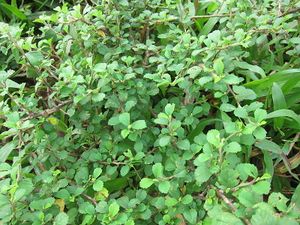Note: This is a project under development. The articles on this wiki are just being initiated and broadly incomplete. You can Help creating new pages.
Sida rhombifolia - Devabala
Sida rhombifolia is widely distributed in the tropics and occurs in almost all countries of tropical Africa. In Niger, DR Congo and the Central African Republic it is cultivated as a fibre crop, and in India, Australia and the Americas as well.
Uses
The bark of Sida rhombifolia yields fibres that are used in the same way as those of jute (Corchorus spp.). In Niger the fibres are used to make fishing-lines and nets and in the Central African Republic for making large hunting-nets. The stems are woven to produce wattle-work doors, and in Gabon and Kenya they are used for cleaning the teeth. The whole plants are used as brooms in DR Congo, the Central African Republic and Gabon.
The leaves and shoots are used as a vegetable in South Africa and South America. In Indo-China, the roasted leaves are used for making a refreshing drink. Like most Sida species, Sida rhombifolia is appreciated as a fodder. In East Africa, the wood-tar of Sida rhombifolia is used as a dye and in India it is used for blackening teeth. The leaves are used as a soap-substitute in Gabon and Kenya.In traditional African medicine decoctions of the roots and leaves are widely used as emollients. The leaves or the leaf sap are applied to the skin as an antiseptic and to treat abscesses, ulcers and wounds, for instance in Equatorial Guinea, Gabon, DR Congo, Tanzania and Madagascar. The roots and leaves (DR Congo) or the leaves alone (Gabon) are used as an abortifacient. In Cameroon a watery maceration of the leaves is drunk as an antihypertensive agent, as a sedative, against sexually transmitted diseases and to cure diarrhoea. The same cure for diarrhoea is used in DR Congo where it is also thought to help overcome general stomach complaints and dysentery. Leaves and roots are used in Senegal, the Central African Republic and Madagascar for respiratory diseases like asthma, bronchitis, dyspnoea and pneumonia. The flowers are applied to wasp stings or eaten to ease labour pains. In the Philippines and Indonesia a paste of the leaves mixed with coconut oil is applied to scurf and itch. In Malaysia the plant has been used to treat pulmonary tuberculosis. In Fiji and Papua New Guinea the leaves are used to treat strained muscles, labour pains and migraine. Roots are chewed against toothache in Cameroon and Indonesia, and against dysentery in South-East Asia.
